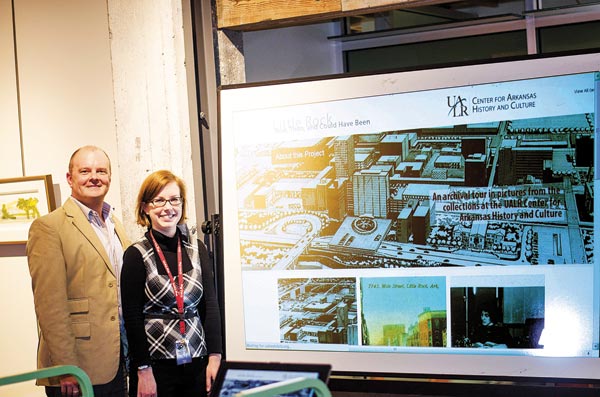Have you ever walked downtown and wondered about the history of a building that you have never noticed before? Take the 100 block of Main Street for instance, and scan the hodge-podge of restaurants and shops located underneath the residential lofts.
A three story building with iron gates and spiral stair-cases hides in plain sight directly next to the cigar shop and parking garage on that block.
Chad Garrett, Director of Technology for UALR’s Center for Arkansas History and Culture (CAHC) had this exact moment recently, in which he noticed the building for the first time, and wondered about its history.
“I was walking from the Main Street parking deck to the Holiday House with my sister and I thought, this looks weird[…]I assumed it had some sort of Spanish influence,” he said. Even though he didn’t have answers right away, his interest was sparked.
Downtown Little Rock is full of collections of stories and small niches of history. Walking around and examining some of the older architecture is enough to prove that fact. The team at CAHC has jumped in on the downtown buzz with their latest virtual exhibit, “Little Rock: Now, Then, and Could Have Been.”
One of the most visual exhibits that the team has created to-date, it has caused quite a stir for local residents. Garrett remembers that the idea came to him this past summer, around the time The Arkansas Times ran a spread envisioning Main Street, coupled with the release of the Creative Corridor Report.
The Creative Corridor Report encompasses what the city plans to do with the ‘cultural stretch’
of Main Street from the 300 to 600 block.
When the report came out, Garrett was struck by the visual elements in both it and the Times’ spread: “I was fascinated really by the pictures and the renderings that the architects had done,” he said.
Garrett also went through the Times’ spread to see if any of the photographs or architectural drawings featured were from the CAHC archives. Finding nothing with the tag, he decided to ask his colleagues to dig for items relating to Main Street, as well as Downtown Little Rock as a whole.
The interns at the time and Shannon Lausch, a resident archivist, started perusing the collection for various items.
In the beginning, meetings were held to come up with a structure for the exhibit’s end-product.
“We really didn’t know what was in the collection. When I initially presented it we talked about how to categorize it and Shannon came up with the different categories, and those were fun, so that gave us a different framework to start searching,” he said.
What was mainly a side project would turn into one of the most visited virtual exhibits currently created by the CAHC staff.
“It was probably the most visual exhibit we’ve done but the easiest. Our whole goal was to let the pictures speak for themselves. It lets people form their own story,” said Garrett.
One can see from the homepage of the exhibit that the iconic photographs lend to simplicity, but also engage the exhibit-goer. Also fun for this project in particular, was the discovery of a video.
Lausch was especially interested in its subject and preservation. She explained it’s significance comparing todays view with those of the 60s-video-era; namely the difference in downtown as being chaotic versus a proposed cultural hub today. “It’s really interesting to see their perspective because the opening of the video is saying that the city is a chaotic place. […] They seem very distraught by that. To them, it was just too hectic and not clean and they did not like that,” she said.
Garrett mentioned that the discovery of a video was a great success for the goal of the archive as a whole.
“We come upon more and more videos,” he explained, “and we are in the process of building this digital services lab which will allow us to digitize and preserve them. That medium will eventually disintegrate. We’re taking them and making them into ones and zeros that we can preserve for forever,” he said.
The most fun for those involved with the project is envisioning what some of the circumstances of the depicted scenes were. For instance, in the archives a picture of a man hanging off a building from around 1912 was found. Both Garrett and Lausch posed a stream of questions:
“What was he doing? Was this the form of entertainment for the time period?”
We will never know, but as Lausch points out, we can vaguely see the Capitol building in the background’s skyline, tying this stranger to our own personal history via the implications of environment.
Garrett also found it interesting to discover architectural renderings for buildings that never came to be. For instance, the plans for a proposed academic structure near Main Street and 630 were found, but the story surrounding its purpose has since been lost.
It is this precise disconnect between the envisioned Little Rock of yesterday with the reality of it today that makes the exhibit so compelling to those who are familiar with the nooks and crannies of downtown.
Speaking of nooks and crannies, let’s revisit that space on the 100 block of Main Street that Garrett noticed recently, but could not place in history.
After doing some digging, Lausch discovered that the original purpose of the space was a sandwich shop called The Angry Bull. Bits of history like this act as little nuggets, relating the then-sandwich shop to the now mysterious, private residence.
The latest exhibit from the CAHC demands a visit, and only requires a computer with internet access to do so. Be sure to click on the “view all” option to retrieve metadata about each photo, because the second you do, you’ll find yourself on a fun, historical journey.
Try it, you just might learn something about the place you call home. Visit the exhibit at the following address: http://ualrexhibits.org/littlerock/.
This article was provided by Becca Bona of the Daily Record, the Daily Newspaper of Law and Business Information. It originally appeared on Friday, November 22, 2013.


